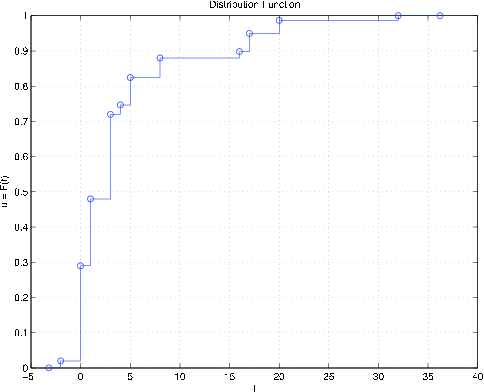| << Chapter < Page | Chapter >> Page > |
% file jdemo3.m
% data for joint simple distributionX = [-4 -2 0 1 3];Y = [0 1 2 4];P = [0.0132 0.0198 0.0297 0.0209 0.0264;
0.0372 0.0558 0.0837 0.0589 0.0744;0.0516 0.0774 0.1161 0.0817 0.1032;
0.0180 0.0270 0.0405 0.0285 0.0360];
jdemo3 % Call for datajcalc % Set up of calculating matrices t, u.
Enter JOINT PROBABILITIES (as on the plane) PEnter row matrix of VALUES of X X
Enter row matrix of VALUES of Y YUse array operations on matrices X, Y, PX, PY, t, u, and P
G = t.^2 -3*u; % Formation of G = [g(ti,uj)]M = G>= 1; % Calculation using the XY distribution
PM = total(M.*P) % Alternately, use total((G>=1).*P)
PM = 0.4665[Z,PZ] = csort(G,P);PM = (Z>=1)*PZ' % Calculation using the Z distribution
PM = 0.4665disp([Z;PZ]') % Display of the Z distribution-12.0000 0.0297
-11.0000 0.0209-8.0000 0.0198
-6.0000 0.0837-5.0000 0.0589
-3.0000 0.1425-2.0000 0.1375
0 0.04051.0000 0.1059
3.0000 0.07444.0000 0.0402
6.0000 0.10329.0000 0.0360
10.0000 0.037213.0000 0.0516
16.0000 0.0180 We extend the example above by considering a function which has a composite definition.
Let
H = t.*(t+u>=1) + (t.^2 + u.^2).*(t+u<1); % Specification of h(t,u)[W,PW] = csort(H,P); % Distribution for W = h(X,Y)disp([W;PW]')-2.0000 0.0198
0 0.27001.0000 0.1900
3.0000 0.24004.0000 0.0270
5.0000 0.07748.0000 0.0558
16.0000 0.018017.0000 0.0516
20.0000 0.037232.0000 0.0132
ddbn % Plot of distribution functionEnter row matrix of values W
Enter row matrix of probabilities PWprint % See
[link]

Joint distributions for two functions of
In previous treatments, we use csort to obtain the marginal distribution for a single function . It is often desirable to have the joint distribution for a pair and . As special cases, we may have or . Suppose
The joint distribution requires the probability of each pair, . Each such pair of values corresponds to a set of pairs of X and Y values. To determine the joint probability matrix for arranged as on the plane, we assign to each position the probability , with values of W increasing upward. Each pair of values corresponds to one or more pairs of values. If we select and add the probabilities corresponding to the latter pairs, we have . This may be accomplished as follows:

Notification Switch
Would you like to follow the 'Applied probability' conversation and receive update notifications?